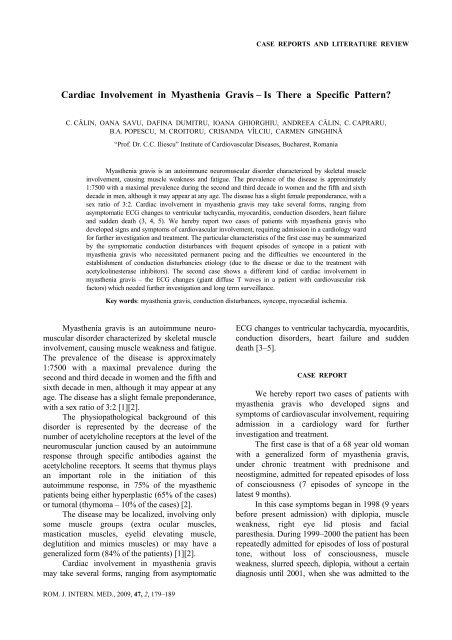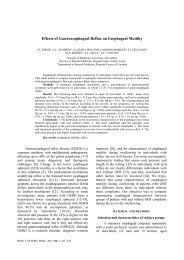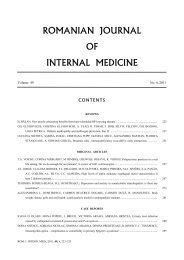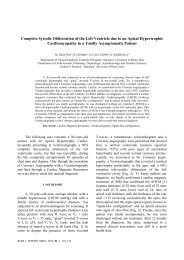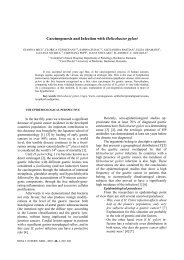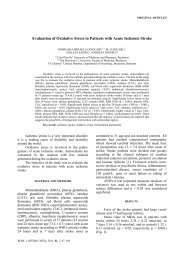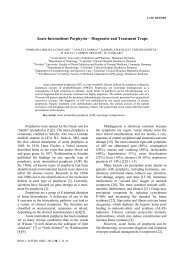Cardiac Involvement in Myasthenia Gravis - Romanian Journal of ...
Cardiac Involvement in Myasthenia Gravis - Romanian Journal of ...
Cardiac Involvement in Myasthenia Gravis - Romanian Journal of ...
You also want an ePaper? Increase the reach of your titles
YUMPU automatically turns print PDFs into web optimized ePapers that Google loves.
CASE REPORTS AND LITERATURE REVIEW<br />
<strong>Cardiac</strong> <strong>Involvement</strong> <strong>in</strong> <strong>Myasthenia</strong> <strong>Gravis</strong> – Is There a Specific Pattern<br />
C. CĂLIN, OANA SAVU, DAFINA DUMITRU, IOANA GHIORGHIU, ANDREEA CĂLIN, C. CAPRARU,<br />
B.A. POPESCU, M. CROITORU, CRISANDA VÎLCIU, CARMEN GINGHINĂ<br />
“Pr<strong>of</strong>. Dr. C.C. Iliescu” Institute <strong>of</strong> Cardiovascular Diseases, Bucharest, Romania<br />
<strong>Myasthenia</strong> gravis is an autoimmune neuromuscular disorder characterized by skeletal muscle<br />
<strong>in</strong>volvement, caus<strong>in</strong>g muscle weakness and fatigue. The prevalence <strong>of</strong> the disease is approximately<br />
1:7500 with a maximal prevalence dur<strong>in</strong>g the second and third decade <strong>in</strong> women and the fifth and sixth<br />
decade <strong>in</strong> men, although it may appear at any age. The disease has a slight female preponderance, with a<br />
sex ratio <strong>of</strong> 3:2. <strong>Cardiac</strong> <strong>in</strong>volvement <strong>in</strong> myasthenia gravis may take several forms, rang<strong>in</strong>g from<br />
asymptomatic ECG changes to ventricular tachycardia, myocarditis, conduction disorders, heart failure<br />
and sudden death (3, 4, 5). We hereby report two cases <strong>of</strong> patients with myasthenia gravis who<br />
developed signs and symptoms <strong>of</strong> cardiovascular <strong>in</strong>volvement, requir<strong>in</strong>g admission <strong>in</strong> a cardiology ward<br />
for further <strong>in</strong>vestigation and treatment. The particular characteristics <strong>of</strong> the first case may be summarized<br />
by the symptomatic conduction disturbances with frequent episodes <strong>of</strong> syncope <strong>in</strong> a patient with<br />
myasthenia gravis who necessitated permanent pac<strong>in</strong>g and the difficulties we encountered <strong>in</strong> the<br />
establishment <strong>of</strong> conduction disturbancies etiology (due to the disease or due to the treatment with<br />
acetylcol<strong>in</strong>esterase <strong>in</strong>hibitors). The second case shows a different k<strong>in</strong>d <strong>of</strong> cardiac <strong>in</strong>volvement <strong>in</strong><br />
myasthenia gravis – the ECG changes (giant diffuse T waves <strong>in</strong> a patient with cardiovascular risk<br />
factors) which needed further <strong>in</strong>vestigation and long term surveillance.<br />
Key words: myasthenia gravis, conduction disturbances, syncope, myocardial ischemia.<br />
<strong>Myasthenia</strong> gravis is an autoimmune neuromuscular<br />
disorder characterized by skeletal muscle<br />
<strong>in</strong>volvement, caus<strong>in</strong>g muscle weakness and fatigue.<br />
The prevalence <strong>of</strong> the disease is approximately<br />
1:7500 with a maximal prevalence dur<strong>in</strong>g the<br />
second and third decade <strong>in</strong> women and the fifth and<br />
sixth decade <strong>in</strong> men, although it may appear at any<br />
age. The disease has a slight female preponderance,<br />
with a sex ratio <strong>of</strong> 3:2 [1][2].<br />
The physiopathological background <strong>of</strong> this<br />
disorder is represented by the decrease <strong>of</strong> the<br />
number <strong>of</strong> acetylchol<strong>in</strong>e receptors at the level <strong>of</strong> the<br />
neuromuscular junction caused by an autoimmune<br />
response through specific antibodies aga<strong>in</strong>st the<br />
acetylchol<strong>in</strong>e receptors. It seems that thymus plays<br />
an important role <strong>in</strong> the <strong>in</strong>itiation <strong>of</strong> this<br />
autoimmune response, <strong>in</strong> 75% <strong>of</strong> the myasthenic<br />
patients be<strong>in</strong>g either hyperplastic (65% <strong>of</strong> the cases)<br />
or tumoral (thymoma – 10% <strong>of</strong> the cases) [2].<br />
The disease may be localized, <strong>in</strong>volv<strong>in</strong>g only<br />
some muscle groups (extra ocular muscles,<br />
mastication muscles, eyelid elevat<strong>in</strong>g muscle,<br />
deglutition and mimics muscles) or may have a<br />
generalized form (84% <strong>of</strong> the patients) [1][2].<br />
<strong>Cardiac</strong> <strong>in</strong>volvement <strong>in</strong> myasthenia gravis<br />
may take several forms, rang<strong>in</strong>g from asymptomatic<br />
ECG changes to ventricular tachycardia, myocarditis,<br />
conduction disorders, heart failure and sudden<br />
death [3–5].<br />
CASE REPORT<br />
We hereby report two cases <strong>of</strong> patients with<br />
myasthenia gravis who developed signs and<br />
symptoms <strong>of</strong> cardiovascular <strong>in</strong>volvement, requir<strong>in</strong>g<br />
admission <strong>in</strong> a cardiology ward for further<br />
<strong>in</strong>vestigation and treatment.<br />
The first case is that <strong>of</strong> a 68 year old woman<br />
with a generalized form <strong>of</strong> myasthenia gravis,<br />
under chronic treatment with prednisone and<br />
neostigm<strong>in</strong>e, admitted for repeated episodes <strong>of</strong> loss<br />
<strong>of</strong> consciousness (7 episodes <strong>of</strong> syncope <strong>in</strong> the<br />
latest 9 months).<br />
In this case symptoms began <strong>in</strong> 1998 (9 years<br />
before present admission) with diplopia, muscle<br />
weakness, right eye lid ptosis and facial<br />
paresthesia. Dur<strong>in</strong>g 1999–2000 the patient has been<br />
repeatedly admitted for episodes <strong>of</strong> loss <strong>of</strong> postural<br />
tone, without loss <strong>of</strong> consciousness, muscle<br />
weakness, slurred speech, diplopia, without a certa<strong>in</strong><br />
diagnosis until 2001, when she was admitted to the<br />
ROM. J. INTERN. MED., 2009, 47, 2, 179–189
180<br />
C. Căl<strong>in</strong> et al. 2<br />
local hospital on an emergency basis for severe<br />
dysphagia, mastication problems and dysarthria. The<br />
diagnosis <strong>of</strong> myasthenia gravis was f<strong>in</strong>ally established<br />
after a positive neostigm<strong>in</strong>e test. The presence or<br />
absence <strong>of</strong> antibodies aga<strong>in</strong>st the acetylchol<strong>in</strong>e receptors<br />
could not be established at that po<strong>in</strong>t. Treatment with<br />
neostigm<strong>in</strong>e and theophyll<strong>in</strong>e was started, with a<br />
partial improvement <strong>of</strong> symptoms.<br />
After an uneventful period <strong>of</strong> time the patient<br />
was admitted to the local hospital for an episode <strong>of</strong><br />
loss <strong>of</strong> postural tone without loss <strong>of</strong> consciousness,<br />
right lid ptosis, diplopia, severe dyspnea and<br />
hypotension (BP 60/40mmHg). She was transferred<br />
to the Fundeni Cl<strong>in</strong>ic Institute, where a CT scan was<br />
performed, show<strong>in</strong>g a 5 cm thymic tumor. The patient<br />
underwent thymectomy <strong>in</strong>clud<strong>in</strong>g the resection <strong>of</strong><br />
both the thymic tumor and the <strong>in</strong>vaded pleura; the<br />
f<strong>in</strong>al diagnosis was: “Thymic tumor with <strong>in</strong>vasion<br />
<strong>of</strong> mediast<strong>in</strong>al and visceral pleura (T2N0M0).<br />
Generalized form <strong>of</strong> myasthenia gravis”. Ten sessions<br />
<strong>of</strong> radiotherapy consolidated the treatment. The<br />
outcome was favorable, with the complete remission<br />
<strong>of</strong> diplopia, dysathria, deglutition and mastication<br />
alter<strong>in</strong>g and the significant improvement <strong>of</strong> muscle<br />
weakness and dyspnea.<br />
Between 2002 and 2006 the patient had a<br />
regular follow-up, the evolution be<strong>in</strong>g stationary<br />
with slight <strong>in</strong>termittent relapses <strong>of</strong> the myasthenic<br />
weakness dur<strong>in</strong>g episodes <strong>of</strong> respiratory <strong>in</strong>fections.<br />
Start<strong>in</strong>g from July 2007 until January 2008<br />
the patient had seven episodes <strong>of</strong> syncope, both <strong>in</strong><br />
exertion and while sitt<strong>in</strong>g (<strong>in</strong>clud<strong>in</strong>g sup<strong>in</strong>e), the<br />
latest episode be<strong>in</strong>g two months previous to the<br />
admission <strong>in</strong> our cl<strong>in</strong>ic.<br />
At the admission <strong>in</strong> our cl<strong>in</strong>ic we were fac<strong>in</strong>g<br />
the situation <strong>of</strong> a patient previously diagnosed with<br />
generalized form <strong>of</strong> myasthenia gravis and a<br />
history <strong>of</strong> repeated episodes <strong>of</strong> syncope, without<br />
relationship to exertion, without prodroma, without<br />
ang<strong>in</strong>a or palpitations, with no postcritical motor<br />
deficits. She presented fatigue, dyspnea at less than<br />
ord<strong>in</strong>ary physical exertion and cough with mucopurulent<br />
sputum.<br />
The family history was unremarkable; as classical<br />
cardiovascular risk factors we can mention severe<br />
essential arterial hypertension (highest BP measured<br />
value <strong>of</strong> 180/90mmHg), dyslipidemia and obesity.<br />
Upon admission the physical exam<strong>in</strong>ation<br />
revealed a slightly altered general status, normal<br />
body temperature, plethora, ecchymoses on the legs,<br />
abdom<strong>in</strong>al type obesity. The muscle exam<strong>in</strong>ation<br />
revealed hypotonia and hypok<strong>in</strong>esia with preserved<br />
reflexes, right lid ptosis. The BP was 120/90mmHg,<br />
without postural hypotension, HR 83 bpm, regular<br />
heart sounds without murmurs, palpable pulses,<br />
without peripheral edema or jugular distension.<br />
The patient was <strong>in</strong> mild respiratory distress with a<br />
respiratory frequency <strong>of</strong> about 35/m<strong>in</strong>, course<br />
vesicular sounds and wheezes, cough with mucopurulent<br />
sputum.<br />
The laboratory evaluation revealed leucocytosis<br />
with neutrophilia, <strong>in</strong>terpreted as secondary to the<br />
respiratory <strong>in</strong>fection, dyslipidemia, slightly elevated<br />
blood urea nitrogen and uric acid.<br />
ECG showed s<strong>in</strong>us rhythm, 83bpm, QRS axis<br />
–10°, first degree atrioventricular block, complete<br />
right bundle branch block with secondary ST-T<br />
changes, q wave <strong>in</strong> aVF and DIII leads (Fig. 1).<br />
Fig. 1. – ECG: s<strong>in</strong>us rhythm, 83bpm,<br />
QRS axis –10°, first degree atrioventricular<br />
block, complete right bundle<br />
branch block with secondary ST-T<br />
changes, q wave <strong>in</strong> aVF and DIII leads.
3 <strong>Cardiac</strong> <strong>in</strong>volvement <strong>in</strong> myasthenia gravis 181<br />
Postero anterior chest X-ray showed elevated<br />
diaphragm, bilateral opacities <strong>in</strong> the costophrenic<br />
angles, enlarged cardiothoracic <strong>in</strong>dex, prom<strong>in</strong>ent<br />
aortic knob, right hilar fibrosis – the same aspect as<br />
shown by previous chest X ray films (Fig. 2).<br />
Fig. 2. – Chest X-ray: bilateral opacities <strong>in</strong> the costophrenic<br />
angles, enlarged cardiothoracic <strong>in</strong>dex, prom<strong>in</strong>ent aortic knob,<br />
right hilar fibrosis.<br />
The neurologic evaluation revealed a 6 po<strong>in</strong>t<br />
QMC score (Quantitative <strong>Myasthenia</strong> <strong>Gravis</strong> Score),<br />
a score <strong>of</strong> 39 po<strong>in</strong>ts represent<strong>in</strong>g a significant deficit.<br />
The episodes <strong>of</strong> syncope <strong>in</strong> this case raised<br />
numerous differential problems. The data were<br />
<strong>in</strong>terpreted accord<strong>in</strong>g to the European Society <strong>of</strong><br />
Cardiology guidel<strong>in</strong>es for the management <strong>of</strong><br />
syncope published <strong>in</strong> 2004 [6]. Based on this, the<br />
follow<strong>in</strong>g types <strong>of</strong> syncope were excluded:<br />
• Neurally-mediated syncope – there was no long<br />
history <strong>of</strong> syncope and the episodes were not<br />
related to specific situations like cough, sneeze,<br />
swallow<strong>in</strong>g, defecation, ur<strong>in</strong>ation, visceral pa<strong>in</strong>,<br />
did not occur dur<strong>in</strong>g or after large meals and<br />
were not associated with nausea or vomit<strong>in</strong>g.<br />
• Orthostatic syncope – the episodes <strong>in</strong> this<br />
patient appeared both <strong>in</strong> sup<strong>in</strong>e and orthostatic<br />
position; the exam<strong>in</strong>ation did not reveal orthostatic<br />
hypotension (decrease <strong>of</strong> SBP>20mmHg or<br />
to
182<br />
C. Căl<strong>in</strong> et al. 4<br />
The ECG and ECG Holter monitor<strong>in</strong>g<br />
(show<strong>in</strong>g complete right bundle branch block, first<br />
degree and <strong>in</strong>termittent second degree type 2 2:1<br />
atrioventricular block) raised the suspicion <strong>of</strong> a<br />
possible arrhythmic cause <strong>of</strong> syncope, further<br />
necessitat<strong>in</strong>g the establishment <strong>of</strong> a specific cause:<br />
• Possible ischaemic etiology – due to the presence<br />
<strong>of</strong> q waves <strong>in</strong> aVF and D III leads<br />
• Possible <strong>in</strong>volvement <strong>of</strong> myasthenia gravis <strong>in</strong><br />
the etiology <strong>of</strong> conduction disorder<br />
• Possible iatrogenic etiology due to acetylchol<strong>in</strong>esterase<br />
<strong>in</strong>hibitors for myasthenia gravis.<br />
Ischaemic etiology <strong>of</strong> the conduction disorder<br />
could be excluded based on a coronary angiography,<br />
which was not possible at the time <strong>of</strong> the admission<br />
due to logistic problems. However, this etiology is<br />
less likely, as the patient denied any history <strong>of</strong><br />
ang<strong>in</strong>a and the echocardiography showed normal<br />
LV wall motion at rest.<br />
Based on the cl<strong>in</strong>ical and laboratory data, the<br />
follow<strong>in</strong>g diagnosis was established:<br />
Heart failure III NYHA class<br />
Syncope<br />
First degree atrioventricular block<br />
Intermittent second degree type 2 atrioventricular<br />
block with periods <strong>of</strong> 2:1 AV conduction<br />
Severe essential arterial hypertension, high added risk<br />
Dyslipidemia<br />
Generalized form myasthenia gravis – under chronic<br />
treatment with glucocorticoids and chol<strong>in</strong>esterase<br />
<strong>in</strong>hibitors<br />
Operated thymoma (2002)<br />
Chronic bronchitis – acute exacerbation.<br />
Due to the underly<strong>in</strong>g conduction disorder –<br />
second degree type 2 atrioventricular block – with<br />
symptoms represented by numerous episodes <strong>of</strong><br />
syncope <strong>in</strong> the latest 9 months <strong>in</strong> a patient with<br />
known neuromuscular disorder, permanent pac<strong>in</strong>g<br />
was performed, without periprocedural <strong>in</strong>cidents.<br />
The treatment at discharge <strong>in</strong>cluded the<br />
myasthenia gravis specific treatment with prednisone<br />
20mg daily, neostigm<strong>in</strong>e 45mg daily with scopolam<strong>in</strong>e,<br />
am<strong>in</strong>ophyll<strong>in</strong>e 400mg daily, calcium and<br />
D3 vitam<strong>in</strong>, salt without natrium, gastric protection,<br />
low-dose diuretic, antiplatelet therapy and stat<strong>in</strong>.<br />
The second reported case is that <strong>of</strong> a 69 year<br />
old male patient, who presented speech and<br />
swallow<strong>in</strong>g problems for about 4 years, diagnosed<br />
with myasthenia gravis secondary to a thymoma<br />
6 months before the admission <strong>in</strong> our cl<strong>in</strong>ic. Three<br />
months after the diagnosis <strong>of</strong> myasthenia gravis and<br />
the <strong>in</strong>itiation <strong>of</strong> methylprednisolone and acetylchol<strong>in</strong>esterase<br />
<strong>in</strong>hibitor therapy the patient presented<br />
an episode <strong>of</strong> acute respiratory failure requir<strong>in</strong>g<br />
orotracheal <strong>in</strong>tubation and mechanical ventilation,<br />
without a clear precipitat<strong>in</strong>g factor. The ECG<br />
dur<strong>in</strong>g the monitor<strong>in</strong>g <strong>in</strong> the ICU ward (Fig. 4)<br />
showed s<strong>in</strong>us rhythm, QRS axis 60°, diffuse giant<br />
negative T waves (leads C2-C5, DI, aVL, DII,<br />
DIII, aVF), with a maximum amplitude <strong>of</strong> 17mm <strong>in</strong><br />
lead C4, corrected QT <strong>in</strong>terval <strong>of</strong> 480ms, without<br />
ECG criteria for left ventricular hypertrophy. There<br />
is also loss <strong>of</strong> septal q wave <strong>in</strong> the left leads. In this<br />
context the patient was further admitted <strong>in</strong> a<br />
cardiology ward for evaluation.<br />
Fig. 4. – ECG dur<strong>in</strong>g the myasthenic crisis: s<strong>in</strong>us rhythm, QRS axis 60°, diffuse giant negative T waves (leads C2-C5, DI, aVL,<br />
DII, DIII, aVF), with a maximum amplitude <strong>of</strong> 17mm <strong>in</strong> lead C4, corrected QT <strong>in</strong>terval <strong>of</strong> 480ms.<br />
The patient denied chest pa<strong>in</strong> and had several<br />
classical cardiovascular risk factors: smok<strong>in</strong>g,<br />
arterial hypertension and dyslipidemia.<br />
This type <strong>of</strong> ECG, with giant diffuse T wave<br />
<strong>in</strong>version and prolonged QT <strong>in</strong>terval, recorded <strong>in</strong> a<br />
situation <strong>in</strong> which the cl<strong>in</strong>ical data does not suggest a
5 <strong>Cardiac</strong> <strong>in</strong>volvement <strong>in</strong> myasthenia gravis 183<br />
specific etiology, imposes several electrocardiographic<br />
differentials; this type <strong>of</strong> repolarisation<br />
changes may be seen <strong>in</strong> subendocardic ischaemianecrosis,<br />
central nervous system (CNS) disorders,<br />
pericarditis, myocarditis, obstructive hypertrophic<br />
cardiomyopathy, metabolic abnormalities, coca<strong>in</strong>e<br />
use, pheochromocytoma and hyperventilation.<br />
Chest X-ray showed a normal cardiothoracic<br />
ratio, without pulmonary or pleural abnormalities.<br />
Electrolytic disorders have been ruled out<br />
based on a normal biological panel. Due to the<br />
suspicion <strong>of</strong> myocardial ischaemia the serum<br />
tropon<strong>in</strong> was determ<strong>in</strong>ed (one measurement) –<br />
positive qualitative test.<br />
Based on the universal def<strong>in</strong>ition <strong>of</strong> myocardial<br />
<strong>in</strong>farction the positive diagnosis is made on the<br />
detection <strong>of</strong> the rise and/or fall <strong>of</strong> cardiac<br />
biomarkers together with at least one <strong>of</strong> the<br />
follow<strong>in</strong>g: ischemic symptoms, ECG changes<br />
<strong>in</strong>dicative <strong>of</strong> new ischaemia, new Q waves or<br />
imag<strong>in</strong>g evidence <strong>of</strong> new loss <strong>of</strong> viable myocardium<br />
or new wall motion abnormalities [7].<br />
In this case a second measurement <strong>of</strong> tropon<strong>in</strong><br />
was not available; although tropon<strong>in</strong> is specific for<br />
myocardial necrosis, there are false positive<br />
situations – critically ill patients, especially those with<br />
respiratory failure or sepsis, myocarditis, hypertrophic<br />
cardiomyopathy and so on.<br />
The first echocardiography showed the<br />
absence <strong>of</strong> regional wall motion abnormalities, but<br />
revealed moderate concentric left ventricular<br />
hypertrophy (<strong>in</strong>terventricular septum 13mm,<br />
posterior wall 13mm) (Fig. 5a and 5b) and normal<br />
left ventricular systolic function. The left ventricular<br />
hypertrophy was considered secondary to the<br />
arterial hypertension, a diagnosis <strong>of</strong> hypertrophic<br />
cardiomyopathy be<strong>in</strong>g considered unjustified <strong>in</strong><br />
this case. A small subendocardic necrosis could not<br />
be elim<strong>in</strong>ated, as <strong>in</strong> this case and especially <strong>in</strong> the<br />
presence <strong>of</strong> LV wall hypertrophy, echocardiography<br />
might not detect subtle wall motion<br />
abnormalities.<br />
Data on giant T wave <strong>in</strong>version shows that<br />
myocardial <strong>in</strong>farction and CNS disorders are major<br />
etiologies. In a series <strong>of</strong> 100 ECGs with T wave<br />
<strong>in</strong>version analyzed by Walder and Spodick [8]<br />
28 patients presented myocardial <strong>in</strong>farction and<br />
23 patients CNS disorders.<br />
In the reported case the cerebral CT scan<br />
was normal.<br />
Therefore, we were not able to determ<strong>in</strong>e a<br />
certa<strong>in</strong> cause <strong>of</strong> the ECG changes, but could not<br />
exclude myocardial necrosis <strong>in</strong> a patient with<br />
multiple cardiac risk factors. Coronary angiography<br />
on an emergency basis was not performed, <strong>in</strong> this<br />
phase the patient be<strong>in</strong>g treated for the acute<br />
respiratory failure; although coronary angiography<br />
is not contra<strong>in</strong>dicated <strong>in</strong> myasthenia gravis, iod<strong>in</strong>e<br />
contrast usage warrants precaution <strong>in</strong> these cases,<br />
as situations <strong>of</strong> muscle weakness exacerbation have<br />
been reported [9].<br />
Fig. 5a. – Transthoracic echocardiography – parasternal long<br />
axis. Interventricular septum 13mm.<br />
Fig. 5a. – Transthoracic echocardiography – parasternal long<br />
axis. Interventricular septum 13mm.<br />
Fig. 5b. – Transthoracic echocardiography – parasternal long<br />
axis; anatomic M-mode. Left ventricle dimensions.<br />
The myasthenic crisis had a favorable outcome<br />
with remission. Dur<strong>in</strong>g the follow<strong>in</strong>g week the ECG<br />
showed no further evolution. Further myocardial<br />
biomarkers determ<strong>in</strong>ations were <strong>in</strong> a normal range.<br />
The physical exam<strong>in</strong>ation <strong>of</strong> the patient after<br />
the myasthenic crisis showed normal BP measurements<br />
under treatment with ACEI and diuretics, without<br />
signs <strong>of</strong> pulmonary or systemic congestion; the<br />
follow<strong>in</strong>g echocardiographic exam<strong>in</strong>ations were similar<br />
to the first one.<br />
Two months after the myasthenic crisis the<br />
ECG shows dynamic changes <strong>in</strong> the anterior leads,<br />
with biphasic T waves <strong>in</strong> leads C2-C6, DI,aVL<br />
(Fig. 6), with no ischaemic or heart failure symptoms.
184<br />
C. Căl<strong>in</strong> et al. 6<br />
Fig. 6. – ECG recorded 2 months after the myasthenic crisis: s<strong>in</strong>us rhythm, biphasic T waves C2-C4, negative T waves C5,<br />
C6, DI, aVL.<br />
One month later the ECG becomes normal<br />
(Fig. 7), without any further changes dur<strong>in</strong>g the<br />
follow<strong>in</strong>g period.<br />
The evolution <strong>of</strong> the ST-T makes hypertrophic<br />
cardiomyopathy even less likely. In this type <strong>of</strong><br />
cardiomyopathy the ECG changes, which may<br />
appear years before the identification <strong>of</strong> left ventricular<br />
hypertrophy [10], do not alter, especially dur<strong>in</strong>g<br />
short periods <strong>of</strong> time.<br />
Fig. 7. – ECG recorded 3 months after<br />
the myasthenic crisis: s<strong>in</strong>us rhythm,<br />
65 bpm, QRS axis 15°, no ST-T changes,<br />
no pathologic Q waves. Corrected QT<br />
<strong>in</strong>terval 350ms.<br />
Thereafter, <strong>in</strong> this case <strong>in</strong> which other causes<br />
<strong>of</strong> giant T waves have been ruled out, a coronary<br />
angiography was performed and showed normal<br />
epicardic coronary arteries (Figs. 8, 9).<br />
Myocardial <strong>in</strong>farction with angiographically<br />
normal coronary arteries is a well-known entity,<br />
with a prevalence <strong>of</strong> 1–12%. It is more frequent <strong>in</strong><br />
young patients and the etiology is still unclear; the<br />
proposed mechanism <strong>in</strong>cludes coronary vasospasm,<br />
thrombosis, platelet dysfunction or vasospastic<br />
syndromes [11]. However, this diagnosis seems<br />
unlikely <strong>in</strong> a 69 year old male with cardiovascular<br />
risk factors, evolv<strong>in</strong>g ECG changes and positive<br />
tropon<strong>in</strong> <strong>in</strong> a situation which may elicit a false<br />
positive result.<br />
In the current situation other disorders with<br />
similar presentation must be considered. The ECG<br />
changes occurred dur<strong>in</strong>g a myasthenic crisis <strong>in</strong> a patient<br />
with myasthenia gravis secondary to a thymoma.<br />
Based on the data about the most frequent cardiovascular<br />
signs and symptoms <strong>in</strong> myasthenia gravis<br />
[3][5][12](Table I) and the data <strong>in</strong> the reported case,<br />
myocarditis should be considered as a differential;<br />
it may be quite frequently encountered <strong>in</strong> patients<br />
with myasthenia gravis, especially <strong>in</strong> the thymoma<br />
associated group (with an up to 61% prevalence <strong>of</strong>
7 <strong>Cardiac</strong> <strong>in</strong>volvement <strong>in</strong> myasthenia gravis 185<br />
histological evidence <strong>of</strong> myocarditis versus 0.6%<br />
prevalence <strong>in</strong> unselected autopsy series) [3].<br />
In this case, although a specific moment <strong>of</strong><br />
acute heart failure is miss<strong>in</strong>g, the f<strong>in</strong>al two<br />
diagnostics considered are myocarditis or NSTEMI<br />
with angiographically normal coronary arteries.<br />
The patient was discharged on medical treatment<br />
for myasthenia gravis (neostigm<strong>in</strong>e, corticosteroids)<br />
and ACE <strong>in</strong>hibitors, diuretic and stat<strong>in</strong>. Until this<br />
article was written the thymectomy has not been<br />
performed yet, so we lack histopathological data.<br />
Fig. 8. – Coronary angiography – RAO – no significant<br />
stenosis <strong>of</strong> the left coronary artery.<br />
Fig. 9. – Coronary angiography – LAO – normal right<br />
coronary artery.<br />
Table I<br />
Cardiovascular disorders <strong>in</strong> patients with myasthenia gravis<br />
(after Gugl<strong>in</strong>[3])<br />
Myocarditis<br />
Giant cell myocarditis<br />
Cor pulmonale<br />
Post thymectomy:<br />
Pericarditis<br />
Arrhythmia<br />
Medication related:<br />
Cyclospor<strong>in</strong>e – arterial hypertension<br />
Chol<strong>in</strong>esterase <strong>in</strong>hibitors:<br />
Bradycardia, asystole<br />
Paroxysmal tachycardia<br />
ECG abnormalities:<br />
Nonspecific ST-T changes<br />
Prolonged QT <strong>in</strong>terval<br />
Arrhythmia<br />
Atrial fibrillation/flutter<br />
S<strong>in</strong>us bradycardia<br />
Bundle branch block<br />
Atrioventricular block<br />
Thymoma related<br />
Post-irradiation <strong>in</strong>jury<br />
DISCUSSION<br />
The aforementioned cases have been chosen<br />
<strong>in</strong> order to underl<strong>in</strong>e the peculiarities and polymorphism<br />
<strong>of</strong> heart <strong>in</strong>volvement <strong>in</strong> myasthenia gravis<br />
and the differential problems that they raised.<br />
The first case portraits a typical myasthenia<br />
gravis, with a classical onset with <strong>in</strong>volvement <strong>of</strong><br />
the cephalic muscles with further generalized<br />
<strong>in</strong>volvement. The positive diagnosis was established<br />
based on the cl<strong>in</strong>ical signs and symptoms and<br />
neostigm<strong>in</strong>e test; due to technical problems the<br />
presence <strong>of</strong> antibodies aga<strong>in</strong>st acetylchol<strong>in</strong>e receptors<br />
was not established; this would have been useful<br />
because cl<strong>in</strong>ical trials have found a connection<br />
between the antibody type and cl<strong>in</strong>ical subtype.<br />
As already mentioned, the pathological<br />
mechanism <strong>of</strong> this disease is the decrease <strong>of</strong> the<br />
acetylchol<strong>in</strong>e receptors at the neuromuscular junction<br />
due to an autoimmune answer mediated through<br />
specific antibodies aga<strong>in</strong>st the acetylchol<strong>in</strong>e receptors.<br />
The acetylchol<strong>in</strong>e receptor has five units (2α, 1β, 1δ,<br />
1γ or ε) around a central pore; the α unit conta<strong>in</strong>s<br />
both the acetylchol<strong>in</strong>e b<strong>in</strong>d<strong>in</strong>g site and the primary<br />
immunogenic site). Anti-AchR antibodies are positive<br />
<strong>in</strong> 85% <strong>of</strong> the generalized form myasthenia gravis<br />
and <strong>in</strong> 50% <strong>of</strong> the ocular form; a negative result<br />
does not exclude the diagnosis, because as far as<br />
40% <strong>of</strong> the cases with negative antibodies have<br />
anti-MuSK (specific muscle k<strong>in</strong>ase) receptors,<br />
which play an important role <strong>in</strong> the post-synaptic<br />
differentiation <strong>of</strong> acetylchol<strong>in</strong>e receptors [1]. The<br />
positive antiMuSK antibodies are more frequently<br />
found <strong>in</strong> female patients and the respiratory and<br />
bulbar muscles are frequently <strong>in</strong>volved. Other<br />
types <strong>of</strong> antibodies <strong>in</strong> myasthenia gravis are antismooth<br />
muscle antibodies (84% <strong>of</strong> the patients<br />
younger than 40 years without thymoma or patients<br />
older than 40 years with thymoma) and striational
186<br />
C. Căl<strong>in</strong> et al. 8<br />
antibodies (antimuscle prote<strong>in</strong> tit<strong>in</strong> and anti<br />
ryanod<strong>in</strong>ic receptor) which connect themselves <strong>in</strong> a<br />
cross l<strong>in</strong>ked pattern on different epitopes on the<br />
skeletal and heart muscles [1]. Almost all patients<br />
with myasthenia gravis and thymoma and half <strong>of</strong><br />
the patients with late onset myasthenia (>50years<br />
old) have these antibodies [1].<br />
A recent study identified correlations between<br />
the cl<strong>in</strong>ical subsets and antibodies type. Anti-Kv1.4<br />
antibodies have been associated with bulbar<br />
<strong>in</strong>volvement, myasthenic crisis, thymoma and<br />
myocarditis and/or myositis; anti-Ach antibodies<br />
correlate with an early onset <strong>of</strong> the disease and<br />
seronegativity is associated with ocular form<br />
myasthenia.<br />
All these data underl<strong>in</strong>e the fact that the<br />
autoimmune answer <strong>in</strong> myasthenia gravis may<br />
<strong>in</strong>volve the myocardium.<br />
Thymus plays an important role <strong>in</strong> the<br />
<strong>in</strong>itiation <strong>of</strong> the autoimmune answer <strong>in</strong> myasthenia<br />
gravis. Antibodies <strong>in</strong> this disease are IgG,<br />
T-lymphocyte dependent. It seems that the myoid<br />
thymic cells, which express acetylchol<strong>in</strong>e receptors,<br />
may serve as an autoantigene source and can trigger<br />
the autoimmune reaction [2]. Thymectomy improves<br />
the symptoms <strong>in</strong> 85%, and <strong>in</strong> 35% <strong>of</strong> the patients they<br />
enter the remission phase without further need <strong>of</strong><br />
medical treatment cont<strong>in</strong>uation [2].<br />
In the first case we presented thymectomy<br />
improved symptomatology, with the complete<br />
disappearance <strong>of</strong> diplopia, dysarthria, deglutition<br />
and mastication problems and the significant<br />
improvement <strong>of</strong> muscle weakness and dyspnea.<br />
The association between myasthenia gravis<br />
and cardiovascular diseases is known for over<br />
100 years, but there is no specific etiologic l<strong>in</strong>k<br />
between the two conditions. Most <strong>of</strong> the data<br />
derive from series <strong>of</strong> patients or case reports.<br />
Gugl<strong>in</strong> and associates [3] studied 108 patients<br />
with myasthenia gravis and found signs <strong>of</strong> cardiac<br />
<strong>in</strong>volvement <strong>in</strong> 16% <strong>of</strong> the cases (atrial fibrillation,<br />
atrioventricular heart blocks, asystole, sudden<br />
death) that could not be expla<strong>in</strong>ed by other causes<br />
and <strong>in</strong>terpreted as due to myocarditis that occurs<br />
dur<strong>in</strong>g the autoimmune <strong>in</strong>volvement. Cl<strong>in</strong>ical signs<br />
<strong>of</strong> unexpla<strong>in</strong>ed cardiovascular <strong>in</strong>volvement occur<br />
especially <strong>in</strong> myasthenia gravis with thymoma<br />
(50%), more <strong>of</strong>ten than <strong>in</strong> myasthenia gravis<br />
without thymoma (only 12%). Arrhythmia is the<br />
most common cl<strong>in</strong>ical manifestation and these<br />
patients are at an <strong>in</strong>creased risk <strong>of</strong> sudden death.<br />
ECG abnormalities may be found <strong>in</strong> 16 to<br />
88% <strong>of</strong> patients with myasthenia gravis; the most<br />
common forms are nonspecific ST-T changes,<br />
abnormal T wave, prolonged QT <strong>in</strong>terval, s<strong>in</strong>us<br />
tachycardia, s<strong>in</strong>us arrhythmia, bundle branch blocks<br />
[3]. Accord<strong>in</strong>g to our data there is only one<br />
reported case <strong>of</strong> transient ECG changes dur<strong>in</strong>g a<br />
myasthenic crisis suggest<strong>in</strong>g anterior acute myocardial<br />
<strong>in</strong>farction [14]. The necropsy <strong>in</strong> that case showed<br />
no coronary abnormalities, but discovered partial<br />
areas <strong>of</strong> <strong>in</strong>terstitial fibrosis.<br />
The mechanism <strong>of</strong> myocardial <strong>in</strong>volvement<br />
<strong>in</strong> myasthenia gravis is still unknown. Some<br />
isolated reports described autoimmune myocarditis.<br />
Similar anatomical changes <strong>in</strong> the myocardium<br />
(focal myocarditis) and skeletal muscles [15] have<br />
led to the idea <strong>of</strong> myocardium <strong>in</strong>volvement <strong>in</strong> the<br />
pathological process <strong>of</strong> the disease.<br />
The earliest evidence <strong>of</strong> heart <strong>in</strong>volvement<br />
goes back to 1901, when Weigert described abnormal<br />
cells <strong>in</strong> the myo- and epicardium <strong>of</strong> a patient with<br />
thymoma. In 1942 Rott<strong>in</strong>o described polymorphic<br />
myocardial histological lesions <strong>in</strong> the myocardium<br />
<strong>of</strong> myasthenia gravis patients, from scarce lymphocytic<br />
<strong>in</strong>filtration, to diffuse myocarditis [16]. The<br />
microscopical lesions <strong>in</strong>clude my<strong>of</strong>ibrillar necrosis,<br />
<strong>in</strong>flammatory changes with edema, hemorrhages,<br />
lymphocytic <strong>in</strong>filtrations, large irregular histiocytes.<br />
These pathological changes are non specific, as they<br />
can also be found <strong>in</strong> thyreotoxicosis, Addison’s<br />
disease and rheumatoid arthritis. Furthermore, the non<br />
specific <strong>in</strong>flammatory changes associated with hypoxia,<br />
hypercapnia and metabolic acidosis associated with<br />
myastenic crisis cannot be neglected [3][17].<br />
Some authors also described myocarditis with<br />
focal cellular <strong>in</strong>filtration, possibly due to antibodies<br />
aga<strong>in</strong>st β1 and β2 receptors, with prolonged QT<br />
<strong>in</strong>terval and non specific ST-T changes [18].<br />
The presence <strong>of</strong> more frequent, more serious<br />
myocardial <strong>in</strong>volvement <strong>in</strong> thymoma patients has<br />
led some <strong>in</strong>vestigators to <strong>in</strong>terprete the myocarditis<br />
<strong>in</strong> these cases as a paraneoplastic phenomenon [3].<br />
Some <strong>of</strong> the non specific ECG changes may be<br />
<strong>in</strong>duced by myocarditis, as autopsy series described<br />
myocardial abnormalities <strong>in</strong> young patients with<br />
myasthenia gravis and ECG changes [7][14].<br />
Besides myocarditis, not always with cl<strong>in</strong>ical<br />
symptoms (especially as one <strong>of</strong> the card<strong>in</strong>al symptoms<br />
<strong>of</strong> myasthenia is fatigue), some cases <strong>of</strong> giant cells<br />
myocarditis with rapid progression have also been<br />
described, more frequent <strong>in</strong> a perioperative sett<strong>in</strong>g.
9 <strong>Cardiac</strong> <strong>in</strong>volvement <strong>in</strong> myasthenia gravis 187<br />
Most <strong>of</strong> the studies concern<strong>in</strong>g ECG changes<br />
and myocardial <strong>in</strong>filtration <strong>in</strong> myasthenia gravis<br />
were conducted before the era <strong>of</strong> coronary<br />
angiography, so that there is difficult to <strong>in</strong>terpretate<br />
them especially <strong>in</strong> thymoma patients, who are<br />
usually older male patients, with a high probability<br />
<strong>of</strong> ischemic heart disease. A contemporary review<br />
<strong>of</strong> these data with modern technique would be <strong>of</strong><br />
real <strong>in</strong>terest.<br />
In the second case we reported, myocarditis is a<br />
plausible cause <strong>of</strong> ECG evolv<strong>in</strong>g changes <strong>in</strong> the<br />
context <strong>of</strong> angiographically normal coronary arteries.<br />
Some technical limits <strong>in</strong> the paracl<strong>in</strong>ical<br />
<strong>in</strong>vestigations have led to the impossibility <strong>of</strong><br />
establish<strong>in</strong>g a certa<strong>in</strong> diagnosis: lack <strong>of</strong> quantitative<br />
measurements <strong>of</strong> tropon<strong>in</strong> level <strong>in</strong> dynamics, lack<br />
<strong>of</strong> ECG for comparison, BNP measurement <strong>in</strong> the<br />
acute episode, <strong>of</strong> myocardial sc<strong>in</strong>tigraphy with<br />
monoclonal Indium labeled antimyos<strong>in</strong> antibodies<br />
or Galium sc<strong>in</strong>tigraphy or cardiac MRI exam.<br />
A recent study [19] suggested that functional<br />
changes are frequent <strong>in</strong> myasthenia gravis. Autonomous<br />
nervous system, both sympathetic and parasympathetic,<br />
is affected <strong>in</strong> myasthenia gravis, but<br />
the impact <strong>of</strong> these changes on heart function is<br />
still unclear. It has also been proven that the<br />
patients with myasthenia gravis and autoimmune<br />
autonomous neuropathy [20] have antibodies<br />
aga<strong>in</strong>st the nicot<strong>in</strong>ic receptor for acetylchol<strong>in</strong>e<br />
located <strong>in</strong> the skeletal muscle (a classical f<strong>in</strong>d<strong>in</strong>g <strong>in</strong><br />
myasthenia gravis) and specific antibodies aga<strong>in</strong>st<br />
the acetylcol<strong>in</strong>e receptors located <strong>in</strong> the ganglia on<br />
the nerves. This f<strong>in</strong>d<strong>in</strong>g may expla<strong>in</strong> the rare, but<br />
possible cl<strong>in</strong>ical association between myasthenia<br />
gravis and autonomous system dysfunction.<br />
Another important part is the possible<br />
iatrogenic heart <strong>in</strong>volvement dur<strong>in</strong>g treatment with<br />
chol<strong>in</strong>esterase <strong>in</strong>hibitors which may cause<br />
bradycardia, hypotension, syncope, atrioventricular<br />
heart blocks due to the <strong>in</strong>creased quantity <strong>of</strong><br />
acethylcol<strong>in</strong>e <strong>in</strong> the synapse. Some reports mention<br />
cases <strong>of</strong> vasospastic ang<strong>in</strong>a [21], acute myocardial<br />
<strong>in</strong>farction due to coronary artery spasm dur<strong>in</strong>g the<br />
col<strong>in</strong>ergic crisis [22] and proarrythmic effects <strong>of</strong><br />
chol<strong>in</strong>esterase <strong>in</strong>hibit<strong>in</strong>g drugs [23].<br />
In the first reported case we do not have enough<br />
data to strictly l<strong>in</strong>k the conduction abnormalities to<br />
the pathogeny <strong>of</strong> the disease (myocarditis or<br />
autonomous nervous system dysfunction) because<br />
<strong>of</strong> lack <strong>of</strong> immunologic panel <strong>of</strong> the patient. The<br />
patient followed a long treatment (2001–2008) with<br />
col<strong>in</strong>-esterase <strong>in</strong>hibitors, a iatrogenic etiology must<br />
be considered <strong>in</strong> this case, with no possibility <strong>of</strong><br />
stopp<strong>in</strong>g or decreas<strong>in</strong>g the dosage due to the<br />
relaps<strong>in</strong>g <strong>of</strong> myasthenic symptoms.<br />
In the cases <strong>of</strong> symptomatic heart blocks with<br />
syncope <strong>in</strong> patients with myasthenia gravis under<br />
treatment with col<strong>in</strong>esterase <strong>in</strong>hibitors the usual<br />
management implies permanent pac<strong>in</strong>g, as <strong>in</strong> the<br />
described case.<br />
A recent published case report describes the<br />
situation <strong>of</strong> a patient with myasthenia gravis under<br />
piridostigm<strong>in</strong>e treatment who developed high grade<br />
atrioventricular block with frequent episodes <strong>of</strong><br />
syncope. In this case the authors chose the<br />
simultaneous treatment with hiosciam<strong>in</strong>e, a<br />
muscar<strong>in</strong>ic antagonist used to block the deleterious<br />
chol<strong>in</strong>ergic side effects. Under the association <strong>of</strong><br />
therapy the atrioventricular block completely<br />
disappeared, there was no further syncope, thereafter<br />
avoid<strong>in</strong>g the permanent pac<strong>in</strong>g. This situation is an<br />
isolated report, moreover the treatment with<br />
hiosciam<strong>in</strong>e is not available <strong>in</strong> Romania.<br />
There is also a case report <strong>of</strong> atrioventricular<br />
block and pericardial effusion <strong>in</strong> a myasthenia gravis<br />
patient, with favourable course under immunosuppressive<br />
therapy and plasmapheresis [4].<br />
In the first case we considered that the patient<br />
had an <strong>in</strong>creased risk <strong>of</strong> sudden death, no matter<br />
the cause <strong>of</strong> the conduction abnormalities and<br />
chose a permanent pac<strong>in</strong>g attitude, even if the<br />
current guidel<strong>in</strong>es do not <strong>in</strong>clude myasthenia gravis<br />
among the neuromuscular disorders with conduction<br />
abnormalities that impose pac<strong>in</strong>g. Accord<strong>in</strong>g to the<br />
ACC/AHA 2002 guidel<strong>in</strong>es for implantation <strong>of</strong><br />
cardiac pacemakers and antiarrhythmia devices the<br />
pac<strong>in</strong>g <strong>in</strong>dication <strong>in</strong> our patient is class IIb, level <strong>of</strong><br />
evidence B. The guidel<strong>in</strong>es mention that <strong>in</strong><br />
neuromuscular disorders like myotonic muscular<br />
dystrophy, Kearns Sayre syndrome, Erb dystrophy<br />
and peronier muscular atrophy, the presence <strong>of</strong> an<br />
atrioventricular block <strong>of</strong> any grade (<strong>in</strong>clud<strong>in</strong>g grade<br />
I atrioventricular block) with or without symptoms<br />
permanent pac<strong>in</strong>g is <strong>in</strong>dicated given the impredictable<br />
progression <strong>of</strong> conduction abnormalities <strong>in</strong> these<br />
patients. Accord<strong>in</strong>g to the ESC Pac<strong>in</strong>g and CRT<br />
Guidel<strong>in</strong>es, neuromuscular disorders with second or<br />
third degree atrioventricular block represent a class I<br />
level <strong>of</strong> evidence B recommendation for cardiac<br />
pac<strong>in</strong>g, while the association with first-degree<br />
atrioventricular block is a class IIb level <strong>of</strong> evidence<br />
B recommendation.
188<br />
C. Căl<strong>in</strong> et al. 10<br />
The particular characteristics <strong>of</strong> the first case<br />
may be summarized as follows:<br />
The symptomatic conduction disturbances with<br />
frequent episodes <strong>of</strong> syncope <strong>in</strong> a patient with<br />
myasthenia gravis who necessitated permanent pac<strong>in</strong>g.<br />
The difficulties we encountered <strong>in</strong> the<br />
establishment <strong>of</strong> conduction disturbances etiology<br />
(due to the disease or to the treatment with<br />
acetylchol<strong>in</strong>esterase <strong>in</strong>hibitors).<br />
The second case shows a different k<strong>in</strong>d <strong>of</strong><br />
cardiac <strong>in</strong>volvement <strong>in</strong> myasthenia gravis – the<br />
ECG changes (giant diffuse T waves <strong>in</strong> a patient<br />
with cardiovascular risk factors) which needed<br />
further <strong>in</strong>vestigation and long term surveillance.<br />
Miastenia gravis este o boală musculară autoimună caracterizată pr<strong>in</strong><br />
slăbiciune şi oboseală musculară. Prevalenţa bolii este de aproximativ 1:7500 cu<br />
maxim în decadele 2 şi trei la femei şi c<strong>in</strong>ci şi şase la bărbaţi, deşi poate apare la<br />
orice vârstă. Boala are o uşoară predom<strong>in</strong>anţă fem<strong>in</strong><strong>in</strong>ă cu un sex ratio de 3:2.<br />
Afectarea cardiacă în miastenia gravis poate lua câteva forme, mergând de la<br />
modificări EKG asimptomatice la tahicardie ventriculară, miocardită, tulburări de<br />
conducere, <strong>in</strong>suficienţă cardiacă şi moarte subită (3, 4, 5). Vă prezentăm în<br />
cont<strong>in</strong>uare două cazuri de miastenia gravis care au dezvoltat semen şi simptome de<br />
afectare cardiovasculară care au necesitat <strong>in</strong>ternare într-un serviciu de cardiologie<br />
pentru evaluare şi tratament. Astfel, primul caz este particular pr<strong>in</strong> prezenţa<br />
tulburărilor de conducere simptomatice, cu frecvente s<strong>in</strong>cope care au necesitat<br />
cardiostimulare permanentă precum şi pr<strong>in</strong> dificultatea stabilirii etiologiei tulburării<br />
de conducere (datorată bolii în s<strong>in</strong>e sau tratamentului cu <strong>in</strong>hibitori de acetilcol<strong>in</strong>esterază).<br />
Cel de-al doilea caz prez<strong>in</strong>tă afectarea cardiacă manifestată pr<strong>in</strong><br />
modificări de ischemie difuze, care a necesitat <strong>in</strong>vestigaţii suplimentare şi urmărire.<br />
Correspond<strong>in</strong>g author: Carmen G<strong>in</strong>gh<strong>in</strong>ă, MD, PhD, FESC, FACC<br />
100, V. Lascăr Str.<br />
020506 Bucharest, Romania<br />
E-mail: carmeng<strong>in</strong>gh<strong>in</strong>a2001@yahoo.com<br />
REFERENCES<br />
1. AASHIT K. SHAH, MD, <strong>Myasthenia</strong> <strong>Gravis</strong>, Emedic<strong>in</strong>e, 10, 2006.<br />
2. FAUCI A., BRAUNWALD E., KASPER D., Harrison’s Pr<strong>in</strong>ciples <strong>of</strong> Internal Medic<strong>in</strong>e, Ed. 16, McGraw-Hill.<br />
3. GUGLIN M., CAMPELLONE J., HEINTZ K., PARILLO J., <strong>Cardiac</strong> disease <strong>in</strong> myasthenia gravis: a literature review. J. Cl<strong>in</strong>.<br />
Neuromusc. Dis., 2003; 4:199–203.<br />
4. HEMENDER S., MD, RICHARDSON, STEVEN K., Pericarditis <strong>in</strong> <strong>Myasthenia</strong> <strong>Gravis</strong>, Cardiology <strong>in</strong> Review, 2004,<br />
12(3):134–137.<br />
5. BRAUNWALD E., LIBBY P., BONOW R., MANN D., ZIPES D., Braunwald’s Heart Disease – A Textbook <strong>of</strong> Cardiovascular<br />
Medic<strong>in</strong>e, Ed. 8, Saunders, 2007: 2149.<br />
6. BRIGNOLE M., ALBONI P., BERGFELDT L., BLANC J., Guidel<strong>in</strong>es on Management (Diagnosis and Treatment) <strong>of</strong> Syncope-<br />
Update 2004, Europace (2004), 6, 467–537.<br />
7. THYGESEN K., ALPERT J., WHITE D. on behalf <strong>of</strong> the Jo<strong>in</strong>t ESC/ACCF/AHA/WHF Task Force for the redef<strong>in</strong>ition <strong>of</strong><br />
Myocardial Infarction. Universal def<strong>in</strong>ition <strong>of</strong> myocardial <strong>in</strong>farction. EHJ 2007; 28(20):2525–2538.<br />
8. WALDER L.A., SPODICK D.H., Global T wave <strong>in</strong>version. J. Am. Coll. Cardiol., 1991; 17:1479.<br />
9. FRANK J.H., COOPER G.W., BLACK W.C., PHILLIPS L.H., 2 nd , Iod<strong>in</strong>ated contrast agents <strong>in</strong> myasthenia gravis. Neurology,<br />
1987 Aug., 37(8):1400–1402.<br />
10. APETREI E., RUGINA M., STOIAN I., ALEXANDRU D., COMAN I., GINGHINA C., Should electrocardiographic changes<br />
precede the appearance <strong>of</strong> echocardiographic hypertrophy <strong>in</strong> familial hypertrophic cardiomyopathy (Study <strong>of</strong> 51 families).<br />
Congresul ESC 2007, 1–5 September 2007, Vienna.<br />
11. CHANDRASEKARAN B., KURBAAN A.S., Myocardial <strong>in</strong>farction with angiographically normal coronary arteries. J. R. Soc.<br />
Med., 2002; 95(8):398–400.<br />
12. COHLE S., LIE J.T., <strong>Myasthenia</strong> <strong>Gravis</strong>-Associated Systemic Vasculitis and Myocarditis with <strong>Involvement</strong> <strong>of</strong> the <strong>Cardiac</strong><br />
Conduction Tissue. Cardiovasc. Pathol., 1996; 5:159–162.
11 <strong>Cardiac</strong> <strong>in</strong>volvement <strong>in</strong> myasthenia gravis 189<br />
13. SUZUKI S., UTSUGISAWA K., NAGANE Y., Classification <strong>of</strong> myasthenia gravis based on autoantibody status, Pub. Med..<br />
Arch. Neurol., 2007, 64(8):1121–4.<br />
14. KOHN P.M., TUCKER H.J., KOZOKOFF N.J., The cardiac manifestations <strong>of</strong> myasthenia gravis with particular reference to<br />
electrocardiographic abnormalities. Am. J. Med. Sci., 1965; 249:561–569.<br />
15. HOFSTAD H., OHM O.J., MORK S.J., AARLI J.A., Heart disease <strong>in</strong> myasthenia gravis, Acta Neurologica Scand<strong>in</strong>avica,<br />
1984, 70(3):176–84.<br />
16. ROTTINO A., POPPITTI R., RAO J., Myocardial lesions <strong>in</strong> myasthenia gravis. Arch. Pathol., 1942; 34:557–561.<br />
17. GIBSON T.C., The heart <strong>in</strong> myasthenia gravis. Am. Heart J., 1975; 90(3):389–396.<br />
18. CRAWFORD M.H., DIMARCO J.P., PAULUS W.J., Cardiology, Mosby 2nd edition (December 1, 2003), 22, 1–22.10.<br />
19. ASENSIO E., GOMEZ M., NARVAEZ R., CASTILLO L., Description <strong>of</strong> the rest<strong>in</strong>g electrocardiogram <strong>in</strong> a series <strong>of</strong> patients<br />
with myasthenia gravis, Rev. Invest. Cl<strong>in</strong>., 2003 May–June, 55(3):270–5.<br />
20. VERNINO S., CHESHIRE W.P., LENNON V.A., <strong>Myasthenia</strong> gravis with autoimmune autonomic neuropathy, Auton.<br />
Neuroscience, 2001, 14; 88(3):187–92.<br />
21. SUZUKI M., YOSHII T., OHTSUKA T., Coronary spastic ang<strong>in</strong>a <strong>in</strong>duced by antichol<strong>in</strong>esterase medication for myasthenia<br />
gravis-a case report, Angiology, 2000 Dec.; 51 (12):1031–4.<br />
22. COMERCI G., BUFFON A., BIONDI-ZOCCAI G.G., Coronary vasospasm secondary to hypercol<strong>in</strong>ergic crisis: an iatrogenic<br />
cause <strong>of</strong> acute myocardial <strong>in</strong>farction <strong>in</strong> myasthenia gravis. Int. J. Cardiol., 2006 Nov., 10; 113(2):270–1.<br />
23. LEENDHARDT A., THOMAS O., HAOUALA H., Pro-arrythmia effect <strong>of</strong> pyridostigm<strong>in</strong>e. Apropos <strong>of</strong> a case. Arch. Mal<br />
Coeur Vaiss, 1992 Dec.; 85(12):1853–6.<br />
24. GEHI A., MD, BENATAR M., MD, LANGBERG J., MD, Treatment <strong>of</strong> Pyridostigm<strong>in</strong>e-Induced AV block with Hyosciam<strong>in</strong>e <strong>in</strong><br />
a Patient with <strong>Myasthenia</strong> <strong>Gravis</strong>. <strong>Journal</strong> <strong>of</strong> Cardiovascular Electrophysiology, 2008, 19(2), 214–216.<br />
25. GREGORATOS G., ABRAMS J., EPSTEIN E., ACC/AHA/NASPE 2002, Guidel<strong>in</strong>e Update for Implantation <strong>of</strong> <strong>Cardiac</strong><br />
Pacemakers and Antiarrythmia Devices. Circulation, 2002; 106; 2145–2161.<br />
26. VARDAS E., AURICCHIO A., BLANC J., DAUBERT J.C., Guidel<strong>in</strong>es for cardiac pac<strong>in</strong>g and cardiac resynchronization<br />
therapy <strong>of</strong> the European Society <strong>of</strong> Cardiology, European Heart <strong>Journal</strong>, 2007, 28, 2256–2295.<br />
Received March 15, 2009
190<br />
C. Căl<strong>in</strong> et al. 12


